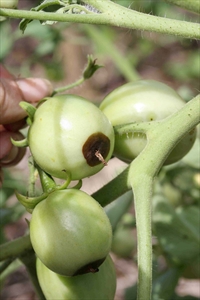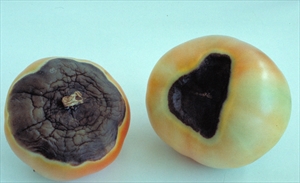Blossom-end rot
Pacific Pests, Pathogens and Weeds - Online edition
Pacific Pests, Pathogens & Weeds
Tomato blossom end rot (082)
Blossom-end rot has a 'physiological' cause; it is due to a lack of calcium. It is not caused by insects, fungi, bacteria, or any other pathogens. It is not a disease.
Wherever tomatoes are grown.
Mostly a problem of tomato, although eggplant, capsicum and watermelon are also affected.
A physiological disorder caused by a lack of calcium from the soil during dry times. The first sign of the disease is a clear or light brown area - often said to look 'water-soaked' - at the blossom end of the fruit, which eventually becomes dark brown or black, dry, sunken and leathery (Photos 1&2). Blossom end rot occurs at any time when plants are flowering and fruiting, but it is more common on the first fruit. Sometimes, fungal moulds grow on the surface of the rot after it has dried, and they are mistaken for the cause.
Blossom end rot is caused by a lack of calcium in the plant. This may mean that there is not enough calcium in the soil, or that it is present but the roots cannot take it up. Calcium is important in the growth of cell walls. It is especially important in rapidly developing parts of plants, such as the fruits. If there is not enough calcium, cells die and tissues rot; as seen here in the fruits.
There are several reasons why fruits show signs of blossom end rot. These are:
- A lack of calcium in the soil - sandy soils lack calcium.
- Water - if there is either too little water, or too much, plants become short of calcium. For example, when plants are grown in plastic bags or on raised beds, and given too little water, the soil around the roots dries out, then becomes water-repellent, and difficult to wet again.
- Hot and dry - if there is increased water loss from the leaves (a process called transpiration) because it is hot and dry, then plants divert water containing calcium from the fruits, and the fruits suffer.
- pH - if the pH of the soil is too low, calcium may be unavailable to the roots.
- Nitrogen - too much nitrogen fertilizer makes the problem worse; this is because nitrogen stimulates rapid vegetative growth and this requires calcium for the cell walls. The result is competition between the demands of fruits and other parts of the plant.
Symptoms of blossom-end rot first appear when the fruits are one-third to one-half full size, and still green. Not only are the fruits unsightly, and they may have moulds growing on the black areas, but also they ripen prematurely, and are inedible. They are neither fit for the market or home use. Losses can be severe, up to 50%.
Look for black areas of rot at the blossom end of developing fruits, especially on the first formed trusses; look to see if the rots are covered in fungal moulds.
CULTURAL CONTROL
The most common cause of blossom-end rot is erratic watering so that the plants get too little or too much water.
Before planting:
- If there is a chance that the plants will get too much water, plant them on raised beds to improve soil drainage.
During growth:
- Grow tomatoes in well-drained soil that contains plenty of organic matter, especially well-rotted manure (but see use of chicken manure below); organic matter holds water, and also gives the plants the nutrients they need, including calcium.
- Do not allow the soil to dry out; try to make sure that the soil is moist at all times, particularly at the flowering stage.
- Mulch the plants after transplanting with dried grasses, and other dried weeds, to help prevent the soil from drying out. The mulch should be at least 10 cm thick (grass clippings are suitable as is black plastic).
- Do not cultivate too closely to plants (nor too deeply) as this may damage the roots, and stop uptake of water and minerals, including calcium.
- Do not use urea or ammonium types of fertilizers. Use of chicken manure should also be avoided.
- Shade plants, or use windbreaks, when conditions are hot, dry and windy, and when the soil moisture is low.
RESISTANT VARIETIES
Varieties differ in susceptibility to blossom end rot, with plum or pear shaped varieties being the more susceptible. In the USA, the following may have tolerance: Jet Star, Burpee VF, Better Boy, Early Girl, Flora-Dade, Floramerica, and Walter.
CHEMICAL CONTROL
Not a method of control for this disorder.
AUTHORS Suzanne Neave & Grahame Jackson
Information from Blossom end rot (2018) Plant Disease Diagnostic Clinic, Plant Pathology and Plant-Microbe Biology Section, Cornell University College of Agriculture and Life Sciences. (http://plantclinic.cornell.edu/factsheets/blossomendrot.pdf); and from Growing vegetables: Managing blossom end-rot. University of New Hampshirre. (https://extension.unh.edu/resource/growing-vegetables-managing-blossom-end-rot-fact-sheet-0). Photo 2 Kohler F, et al. (1997) Diseases of cultivated crops in Pacific Island countries. South Pacific Commission. Pirie Printers Pty. Limited, Canberra, Australia.
Produced with support from the Australian Centre for International Agricultural Research under project PC/2010/090: Strengthening integrated crop management research in the Pacific Islands in support of sustainable intensification of high-value crop production, implemented by the University of Queensland and the Secretariat of the Pacific Community.





